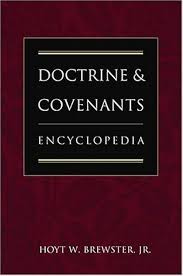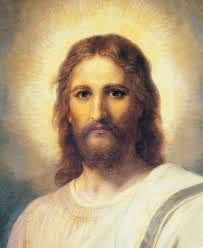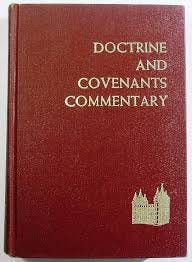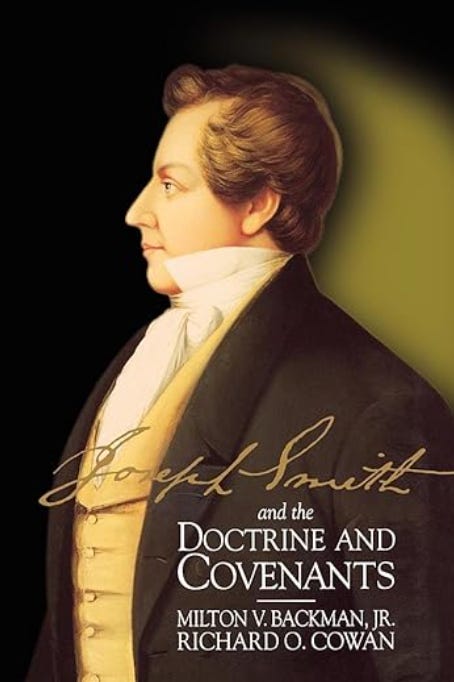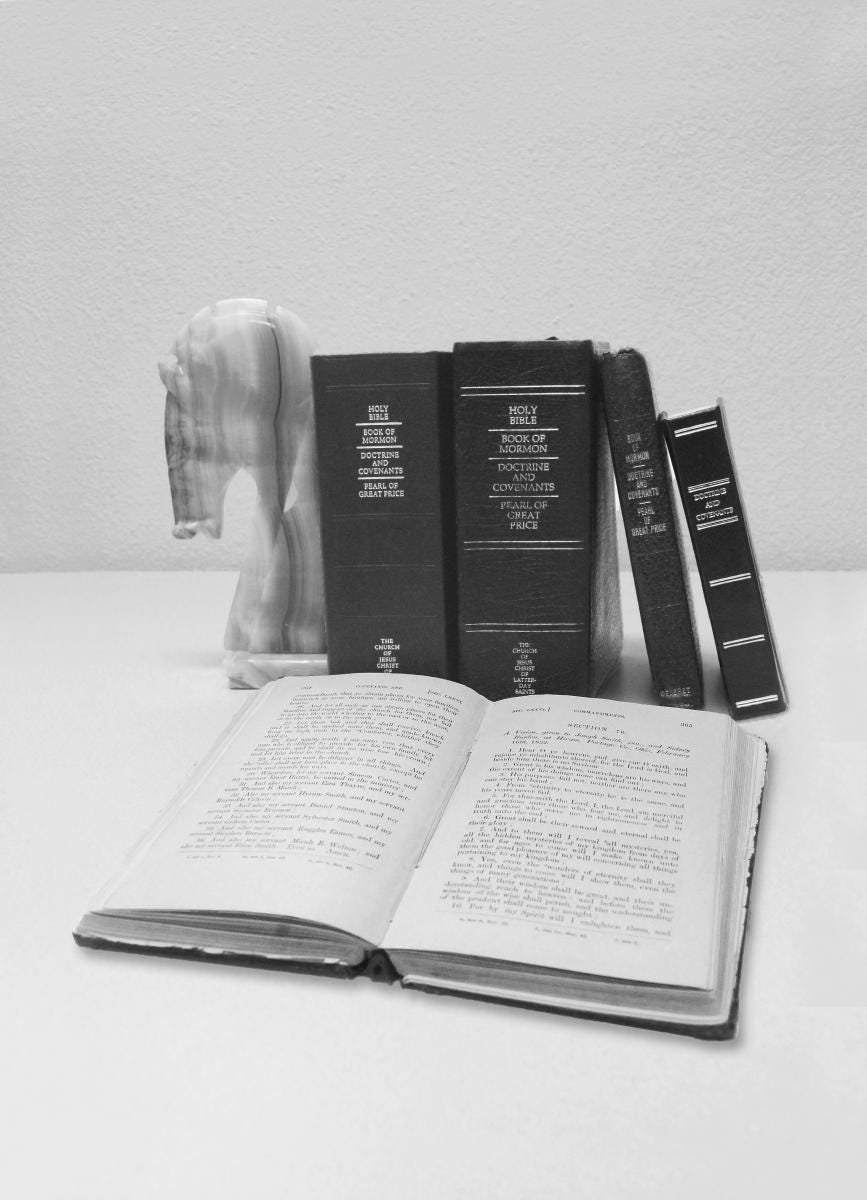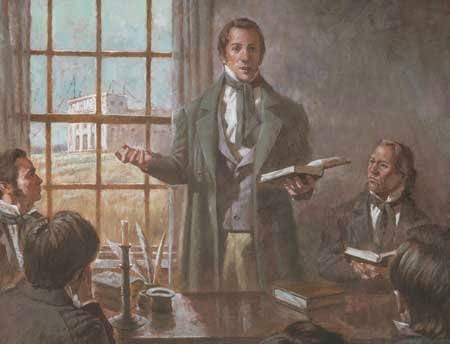An Awful Responsibility to Write in the Name of the Lord
Historical Background for Doctrine and Covenants Section 67
This week we are studying Doctrine and Covenants 67-70 in the LDS Come Follow Me curriculum. The authors of this curriculum introduce these sections as follows:
From 1828 to 1831, the Prophet Joseph Smith received many revelations from the Lord, including divine counsel for individuals, instructions on governing the Church, visions of the latter days, and many inspiring truths of eternity. But many of the Saints hadn’t read them. The revelations weren’t yet published, and the few available copies were handwritten on loose sheets that were circulated among members and carried around by missionaries.
Then, in November 1831, Joseph called a council of Church leaders to discuss publishing the revelations. After seeking the Lord’s will, these leaders made plans to publish the Book of Commandments—the precursor to today’s Doctrine and Covenants. Soon everyone would be able to read for themselves the word of God revealed through a living prophet, vivid evidence that “the keys of the mysteries of the kingdom of our Savior are again entrusted to man.” For these and many other reasons, Saints then and now consider these revelations to be “worth … the riches of the whole Earth” (Doctrine and Covenants 70, section heading).
See Saints, 1:140–43.
I appreciate this wonderful introduction to these sections because it describes how eager the early Saints were to read and study the revelations of the Prophet Joseph Smith. Once the revelations were published, the early Saints must have read them and studied them with delight, feasting upon the words of Christ, and obtaining their own personal testimonies that “the keys of the mysteries of the kingdom of our Savior are again entrusted to man.”
I wonder, however, how eager we modern Latter-day Saints are to read and study these revelations. Just because the Standard Works have been painstakingly compiled, organized, edited, and prepared for us during the two centuries since they were first brought to light does not mean that we automatically appreciate them or understand what they contain. In fact, if my recent experiences in Sunday School classes and in other conversations with modern members of the Church are any gauge for the general scriptural education in the Church, then I’m sorry to report that we know and understand much less than even those early Saints who hadn’t read the revelations because they had not yet been published. Many of the early Saints hadn’t read the revelations because they could not. Many of the modern Saints haven’t read the revelations because…
Why haven’t we read the revelations? Thankfully, there are always positive exceptions to this general observation. I still believe that, as the authors of the LDS Come Follow Me curriculum indicate, many “Saints then and now consider these revelations to be ‘worth … the riches of the whole Earth’ (Doctrine and Covenants 70, section heading).” I am grateful for those good Saints who have read, thoroughly studied, and done their best to live by the doctrine of Christ contained in the Holy Scriptures, including the Doctrine and Covenants. But are there some among us who consider the riches of the whole Earth, or even just a small portion of the riches of the whole Earth, to be worth more than the revelations? In my experience and in my observation, to put it gently, we have much room for improvement.
In connection with these observations, consider Hoyt W. Brewster, Jr.’s entry on “Doctrine and Covenants” in his Doctrine and Covenants Encyclopedia:
The Book of Commandments, intended for publication in 1833, was the name of the original volume of revelations which have since been incorporated into the Doctrine and Covenants. This latter volume has over twice as many revelations as the original book. The origin of the name is unclear, although it does appear in an entry in Joseph Smith’s journal, dated November 3, 1831 (HC 1:229). It was first published under this name in 1835. It is a book containing “doctrine” and “covenants” given by the Lord to his people in these last days. “‘Doctrine’ means ‘teaching,’ ‘instruction.’ It denotes more especially what is taught as truth, for us to believe, as distinct from precepts, by which rules, to be obeyed are given. ‘Doctrine’ refers to belief; precept to conduct…. The word ‘covenant’ is a term by which God indicates the settled arrangement between Him and His people.” (SS, 14.)
President Joseph Fielding Smith made the following observations regarding the book and its title: “The Doctrine and Covenants…. , how much more significant it is than the Book of Commandments. A Book of Commandments means, if we accept the title at its face value, that it contains only commandments. But this title which the Lord gave…. is very significant and tells the story of what this book actually is. It contains the doctrine of the Church; it contains the covenants the Lord will make with the Church, if we are willing to receive them.
“In my judgment there is no book on earth yet come to man as important as the book known as the Doctrine and Covenants.” (DS 3:198)
The significance of the Doctrine and Covenants to the entire world was stressed in an early conference address by Elder Joseph Fielding Smith in the following words: “The Lord has given so many revelations, in our own day. We have this Doctrine and Covenants full of them, all pertaining unto the Latter-day Saints and to the world. For this is not our book alone…. The Lord has given it unto the world for their salvation…; it belongs to all the world, not only to the Latter-day Saints, and they will be judged by it, and you will be judged by it… and if we fail to comprehend these things, if we will not take hold on the things which the Lord has revealed unto us, then his condemnation shall rest upon us, and we shall be removed from his presence and from his kingdom.” (CR, Oct. 1919, p. 146.)
The Lord’s admonition regarding this book of scripture is, “Search these commandments, for they are true and faithful, and the prophecies and promises which are in them shall all be fulfilled” (D&C 1:37).
See also: Book of Commandments
I know that the Lord’s admonition and testimony is true. Joseph Fielding Smith’s declaration is also true.
The early history of the Restored Church of Jesus Christ (including the first decade) is fascinating, but I think that it is at this point, in the early 1830s in Ohio, is when things become even more fascinating.
What is the historical background for Doctrine and Covenants 67?
Smith and Sjodahl introduce this section as follows:
A special conference was held at Hiram, Ohio, on the first day of November, 1831. Oliver Cowdery and John Whitmer were making preparations for the journey to Independence, where the Revelations received up to this time were to be published, and the brethren devoted a great deal of time to the consideration of this important undertaking. The conference authorized the printing of ten thousand copies under the title of the Book of Commandments. The Revelation contained in Section 1, and known as The Lord’s Preface to the Book of Commandments (Sec. 1:6) was also received on this occasion. The Prophet asked what testimony those present were willing to bear to the Commandments. Several declared that they were willing to testify that they were of the Lord. On the second day of the Conference, Oliver Cowdery read The Lord’s Preface, and then the brethren arose, and each in turn testified to the truth of all the Revelations received (Hist. of the Church, Vol. I., p. 222)
However, there was not perfect harmony among the brethren. A few criticized the language found in some of the Revelations. They forgot that the spirit of God uses as they are, the instruments through which He communicates with man, just as an author, when writing, makes use of whatever pen, paper, and ink he may be able to obtain. They forgot that God calls to the prophetic office men as He finds them, be it behind the plough, among the sheep, in the royal courts, or the study of the scholar.
Some of the brethren did not fully realize that divine inspiration is independent of university education, and they were wavering in their faith. The Lord, therefore, gave this Revelation in which He (1) assured them of His presence (1-2); (2) gave the reasons why blessings are withheld (3); (3) offered them a test of the divine origin of the Revelations received (4-9); and (4) closed with promises and admonitions (10-14). (pp. 403-404)
In his book The Revelations of the Prophet Joseph Smith, Lyndon W. Cook sheds more light on the historical background for this section:
Date. November 1831 (1 November).
Circumstantial evidence found in both the History of the Church (1:226) and the “Far West Record” (p. 19) reveals that section 67 was received on 1 November 1831.
Place. Hiram, Portage County, Ohio.
Historical Note. Some of the ten elders present at the Hiram Conference (Joseph Smith, Oliver Cowdery, David Whitmer, John Whitmer, Peter Whitmer, Jr., Sidney Rigdon, William E. McLellan, Luke Johnson, Lyman Johnson, and Orson Hyde) expressed concern over the seemingly uneducated language found in the revelations then ready for printing. In response, Joseph Smith received section 67, which challenged the wised of those present to duplicate any revelation, “even the least that is among them.” William E. McLellan, a newly baptized school teacher from Paris, Tennessee, accepted the challenge but failed.
Care should be taken not to condemn McLellan unduly for his participation in this matter. McLellan had met Joseph Smith for the first time only seven days before this meeting. Because he later became a bitter enemy of the Prophet, it is easy to adopt a retroactive interpretation of this circumstance. Consider section 68, which refers to him as one of “the faithful elders of my church.”
After McLellan’s attempt to write a revelation, Joseph Smith concluded,
“The Elders and all present that witnessed this vain attempt of a man to imitate the language of Jesus Christ, renewed their faith in the fulness of the Gospel, and in the truth of the commandments and revelations which the Lord had given to the Church through my instrumentality.”
Publication Note. Section 67 was first published as section 25 in the 1835 edition of the Doctrine and Covenants. (pp. 107-108)
In his book A Joseph Smith Chronology, J. Christopher Conkling adds the following details to our understanding of the historical background for this section:
Oct. 30, 1831
Orson Hyde, a clerk in the Gilbert and Whitney store and a former Campbellite preacher under Sidney Rigdon, is baptized in Kirtland. (HBB 29 gives this date: HC 1:217 places this occurrence on the first Sunday of October.)
Nov. 1, 1831
A conference is held in Hiram, Ohio. The Saints decide to print 10,000 copies of the Book of Commandments (the collection of Joseph Smith’s revelations up to this date). Oliver is chosen to take the collection to Missouri for printing. Joseph receives the Lord’s preface to the revelations, D&C 1.
Mid-Nov. 1831
Shortly after D&C 1 is given, there is some question and criticism about the language in the revelations, and Joseph receives D&C 67. In it, the Lord bears witness that the revelations are from him, and challenges the wisest among the elders to write a revelation on his own to see if he can duplicate Joseph’s ability. After this revelation is received, McLellin tries to write a commandment but fails. Joseph records, “It was an awful responsibility to write in the name of the Lord.” After this episode, the faith of the elders is increased, and they draw up a testimony to Joseph’s revelations, which cna be seen in D&C, p. iv. (HC 1:226.) Four elders inquire of Joseph the mind of the Lord concerning them, and he receives D&C 68. (p. 28)
In their book Joseph Smith and the Doctrine and Covenants, Milton V. Backman, Jr. and Richard O. Cowan shed even more light on and add the following details to the historical background for this section:
How the Doctrine and Covenants Came to Be
Doctrine and Covenants 1
Revelation through living prophets provides a significant foundation for the faith of the Latter-day Saints. Modern-day divine communications began with the personal appearance of the Father and the Son to Joseph Smith in the early spring of 1820 and have continued to guide the Church ever since. The first step in recognizing these revelations as official scripture came just two months after the Church was organized. At a conference held in Fayette, New York, on 9 June 1830, Joseph Smith read the “Articles and Covenants” (now Doctrine and Covenants 20 and 22), which set forth the basic doctrines, organizations, and procedures of the newly restored Church, and they were accepted unanimously.
Preparations to Publish the Book of Commandments
Initially, the Prophet did not record his revelations at the time he received them, but the Lord instructed him in July 1830 to “continue calling upon God in my name, and writing the things which shall be given thee” (D&C 24:5). Joseph immediately began “copying and arranging the revelations received up to that time, evidently with the view to their publication in book form” (D&C, 1921 ed., p. iii). Parley P. Pratt, who was present when several of these divine communications were given, described how the Prophet received them: “Each sentence was uttered slowly and very distinctly, and with a pause between each, sufficiently long for it to be recorded, by an ordinary writer in long hand. This was the manner in which all his written revelations were dictated and written. There was never any hesitation, reviewing, or reading back, in order to keep the run of the subject” (Autobiography, p. 62). William E. McLellin another close associate, likewise recalled: “I, as scribe, have written revelations from the mouth of [the Prophet]. And I have been present many times when others wrote for Joseph; therefore I speak as one having experience. The scribe seats himself at a desk or table, with pen, ink, and paper. The subject of enquiry being understood, the Prophet and Revelator enquires of God. He spiritually sees, hears, and feels, and then speaks as he is moved upon by the Holy Ghost, the ‘thus saith the Lord,’ sentence after sentence, and waits for his amanuenses to write and then read aloud each sentence. Thus they proceed until the revelator says Amen, at the close of what is then communicated. I have known [Joseph], without premeditation, to thus deliver off in broken sentences, some of the most sublime pieces of composition which I ever perused in any book” (Ensign of Liberty, pp. 98-99).
Of the revelations recorded in the Doctrine and Covenants, some thirty-seven sections, more than one-fourth of the total, were received during 1831 alone. These revelations were copied by hand for the use of the early Saints, but demand for them grew. Therefore, at a conference in November 1831, the Church considered publishing the “Book of Commandments.” During that conference the Lord revealed what is now Doctrine and Covenants 1 to be “my preface unto the book of my commandments” (D&C 1:6). An early LAtter-day Saint cited Oliver Cowdery’s account of what happened on that occasion: “A committee had been appointed to draft a preface, consisting of… O. Cowdery, and, I think, Sidney Rigdon, but when they made their report… the Conference then requested Joseph to enquire of the Lord about it, and he said that he would if the people would bow in prayer with him. This they did and Joseph prayed.
“When they arose, Joseph dictated by the Spirit the preface found in the Book of Doctrine and Covenants while sitting by a window of the room [John Johnson home in Hiram, Ohio] in which the conference was sitting; and Sidney Rigdon would write them down, and read them aloud, and if correct, then Joseph would proceed and deliver more, and by this process the preface was given” (William Kelley, in Saints Herald, 16 Jan. 1882, p. 67). At this point, William E. McLellin voiced some concerns about the wording of the Prophet’s revelations. In response, the Lord issued the challenge quoted in Doctrine and Covenants 67:5-8). “After the foregoing was received,” Joseph wrote in his history, “William E. McLellin, as the wisest man, in his own estimation, having more learning than sense, endeavored to write a commandment like unto one of the least of the Lord’s, but failed; it was an awful responsibility to write in the name of the Lord. The Elders and all present that witnessed this vain attempt of a man to imitate the language of Jesus Christ, renewed their faith in the fulness of the Gospel, and in the truth of the commandments and revelations which the Lord had given to the Church through my instrumentality” (History of the Church, 1:226). Consequently, the conference decided to print several thousand copies of the revelations. Before the conference adjourned, the Lord also revealed what is now Doctrine and Covenants 133 to be an “appendix” for the book." (pp. 1-3)
Backman, Jr. and Cowan note that “the revelations in the Book of Commandments roughly paralleled the first sixty-four sections of our present Doctrine and Covenants,” and that when the new title “Doctrine and Covenants” was given to the book in 1835, it originally included two parts, the seven Lectures on Faith, prepared for use in the School of the Prophets (the doctrine) and the revelations (commonly referred to as the “Covenants and Commandments”). (pp. 3-4) The Lectures on Faith were removed from the book for the 1921 edition of the Doctrine and Covenants, along with the explanation that this material “was never presented to nor accepted by the Church as being otherwise than theological lectures or lessons.” (p. 4)
What a loss! If the Lectures on Faith were good enough for the school of the prophets, why have they been excluded from the Saints’ education? If the Lectures on Faith represent part of “the doctrine” in the title “Doctrine and Covenants,” why excise them?
I’ve read and I love the Lectures on Faith, and I think that they should be restored into the Doctrine and Covenants.
In his chapter “William McLellin’s Five Questions” in Revelations in Context, Matthew C. Godfrey further expands our understanding of the historical background for D&C 67:
Joseph Smith also desired that the participants in the conference provide their testimony of the divine origin of the revelations. Some were reluctant to do so, leading to the dictation of another revelation, now Doctrine and Covenants 67. In this revelation, the Lord provided a way for the elders to determine whether the revelations were from God: “If there be any among you that shall make one like unto” the revelations, it stated, “then ye are Justified in saying that ye do not know that is true,” but if no one could “make one like unto it ye are under condemnation if ye do not bear that it is true.”12
According to one account, McLellin volunteered to try to write his own revelation but failed miserably.13 Thereafter, McLellin, along with other conference attendees, affixed his name to a testimony, prepared by Joseph, stating that “god hath born record to our souls through the Holy Ghost shed forth upon us that these commandments are given by inspiration of God & are profitable for all men & are verily true.”14
After the conference concluded, McLellin stayed with Joseph Smith for another two weeks, copying revelations and preparing for an upcoming mission with Samuel H. Smith to the eastern states.15 He may even have been present on November 3 when Joseph received what would become known as the appendix to the Book of Commandments, which appears in the current Doctrine and Covenants as section 133.
Like Doctrine and Covenants 1, it warned the inhabitants of the earth of Christ’s imminent return and the need to repent and accept God’s direction as provided in the revelations He had given to Joseph. Bolstered by the word of God, McLellin departed for his mission with Samuel Smith on November 16 and preached the gospel for several weeks thereafter.16
McLellin would eventually be called as one of the initial members of the Quorum of the Twelve Apostles.17 Unfortunately, he did not remain true to his testimony; he fell away from the Church and even participated in the persecution of the Saints in Missouri.18 Yet for a few short weeks in the fall of 1831, he was an eyewitness to Joseph Smith’s prophetic calling, witnessing several revelations, including ones addressed directly to him, and participating in the decision to publish the revelations as the Book of Commandments. McLellin, together with other participants in another November 1831 conference, declared that these revelations were “worth to the Church the riches of the whole Earth” and that they contained “the Keyes of the mysteries of the Kingdom, & the riches of Eternity to the church.”19 (pp. 139-140)
It is appropriate that about halfway through the Doctrine and Covenants we have been reminded about the preface and the appendix which encapsulate the purpose and scope of this inspired book. This preface and appendix, along with the historical background for D&C 67 also remind us that our Savior Jesus Christ is the author of this work, Joseph Smith being the chosen instrument for revealing and recording it.
In their chapter 13 “The Gift Has Returned,” the authors of Saints, Vol. I, share the following insights on the historical background for D&C 67:
A few days later, on November 1, 1831, Joseph called a council of church leaders together. Ezra Booth had recently published a letter in a local newspaper accusing Joseph of making false prophecies and hiding his revelations from the public. The letter was widely read, and many people had begun to grow wary of the Saints and their message.15
Many Saints also wanted to read the Lord’s word themselves. Since there were only handwritten copies of the revelations Joseph had received, they were not well known among most church members. Elders who wanted to use them in missionary work had to copy them by hand.
Knowing this, Joseph proposed publishing the revelations in a book. He was confident that such a book would help missionaries share the Lord’s word more easily and provide correct information about the church to curious neighbors.
The council talked the matter over for hours. David Whitmer and a few others opposed publishing the revelations, worried that making the Lord’s plans for Zion more public might cause problems for the Saints in Jackson County. Joseph and Sidney disagreed, insisting that the Lord wanted the church to publish His words.16
After more debate, the council agreed to publish ten thousand copies of the revelations as the Book of Commandments. They assigned Sidney, Oliver, and William McLellin to write a preface to the book of revelations and present it to them later that day.17
The three men began writing immediately, but when they returned with a preface, the council was unhappy with it. They read it over, picking it apart line by line, and asked Joseph to seek the Lord’s will on it. Joseph prayed, and the Lord revealed a new preface for the book. Sidney recorded His words as Joseph spoke them.18
In the new preface, the Lord commanded all people to hearken to His voice. He declared that He had given Joseph these commandments to help His children increase their faith, trust in Him, and receive and proclaim the fullness of His gospel and everlasting covenant. He also addressed the fears of those like David who worried about the content of the revelations.
“What I the Lord have spoken, I have spoken, and I excuse not myself,” He declared, “and though the heavens and the earth pass away, my word shall not pass away, but shall all be fulfilled, whether by mine own voice or by the voice of my servants, it is the same.”19
After Joseph spoke the words of the preface, several members of the council said they were willing to testify of the truth of the revelations. Others in the room were still reluctant to publish the revelations in their current form. They knew Joseph was a prophet, and they knew the revelations were true, but they were embarrassed that the word of the Lord had come to them filtered through Joseph’s limited vocabulary and weak grammar.20
The Lord did not share their concern. In His preface, He had testified that the revelations came from Him, given to His servants “in their weakness, after the manner of their language.”21 To help the men know the revelations came from Him, He issued a new revelation, challenging the council to select the wisest man in the room to write a revelation like the ones Joseph had received.
If the man selected for the task was unable to do it, everyone in the room would know and be responsible to testify that the Lord’s revelations to Joseph were true, despite their imperfections.22
Taking up a pen, William tried to write a revelation, confident in his mastery of language. When he finished, though, he and the other men in the room knew what he had written had not come from the Lord.23 They admitted their error and signed a statement testifying that the revelations had been given to the prophet by the inspiration of God.24
In council, they resolved that Joseph should review the revelations and “correct those errors or mistakes which he may discover by the Holy Spirit.”25
This is Bruce R. McConkie’s section heading for D&C 67:
Revelation given through Joseph Smith the Prophet, at Hiram, Ohio, early November 1831. The occasion was that of a special conference, and the publication of the revelations already received from the Lord through the Prophet was considered and acted upon (see the heading to section 1). William W. Phelps had recently established the Church printing press in Independence, Missouri. The conference decided to publish the revelations in the Book of Commandments and to print 10,000 copies (which because of unforeseen difficulties was later reduced to 3,000 copies). Many of the brethren bore solemn testimony that the revelations then compiled for publication were verily true, as was witnessed by the Holy Ghost shed forth upon them. Joseph Smith’s history records that after the revelation known as section 1 had been received, some conversation was had concerning the language used in the revelations. The present revelation followed.
The Prophet Joseph Smith himself gave this brief introduction to this section:
After this revelation was received [Sec. 66], some conversation was had concerning revelations and language. I received the following: [Section 67, follows.] (HC 1:224, November 1831, Hiram, Ohio.) (Roy W. Doxey Latter-day Prophets and the Doctrine and Covenants, Vol. I., p. 526)
This is the full statement on these matters by the Prophet Joseph Smith as recorded in the History of the Church:
After the foregoing was received [Section 67], William E. McLellin, as the wisest man, in his own estimation, having more learning than sense, endeavored to write a commandment like unto one of the least of the Lord’s, but failed; it was an awful responsibility to write in the name of the Lord. The Elders and all present that witnessed this vain attempt of a man to imitate the language of Christ, renewed their faith in the fullness of the Gospel, and in the truth of the commandments and revelations which the Lord had given to the Church through my instrumentality; and the Elders signified a willingness to bear testimony of their truth to all the world. Accordingly I received the following:
“This testimony of the witnesses to the book of the Lord’s commandments, which He gave to His Church through Joseph Smith, Jun., who was appointed by the voice of the Church for this purpose; we therefore feel willing to bear testimony to all the world of mankind, to every creature upon the face of all the earth and upon the islands of the sea, that the Lord has borne record to our souls, through the Holy Ghost, shed forth upon us, that these commandments were given by inspiration of God, and are profitable for all men, and are verily true. We give this testimony unto the world, the Lord being our helper; and it is through the grace of God, the Father, and His Son, Jesus Christ, that we are permitted to have this privilege of bearing this testimony unto the world, that the children of men may be profited thereby.” (HC 1:226, November 1831.) (Roy W. Doxey, Latter-day Prophets and the Doctrine and Covenants, Vol. I., pp. 527-528)
Let this suffice as historical background for D&C 67. In the following post we will examine and appreciate the revelation itself.







